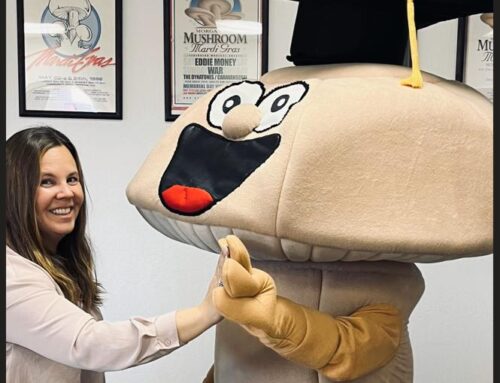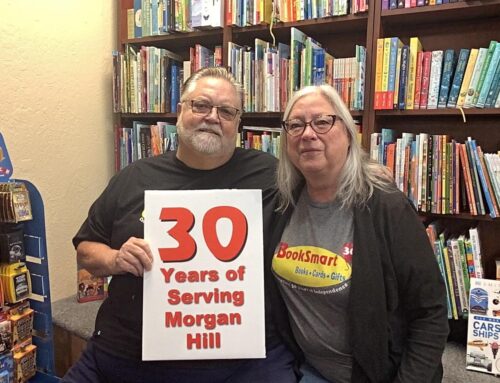Retired firefighter runs Fireworks America focusing on safety first

From left: Jennifer Flores and Lynn Kaminski, Fireworks America
crew members, prepare the pyrotechnics for a past show at the Outdoor Sports Center.
Photo courtesy Wanda Garrett
By Calvin Nuttall

Freedom Fest is a July 3-4 celebration that has been ongoing annually since 1885, according to the nonprofit Independence Day Celebrations. The event includes the children’s patriotic sing and a family music fest in downtown July 3. The next day starts with a 5K Freedom Run, the big parade, car show, and other festivities.
The capstone of the event is Fireworks on the Green at the Morgan Hill Outdoor Sports Center. That’s where San Martin-based pyrotechnic company Fireworks America annually puts on a colorful display after sunset choreographed by Acker.
“It’s my hometown,” he said. “I’ve got a really good, experienced crew who could work anywhere in the world on fireworks, but we like working here for the hometown crowd. We make sure it’s a good time.”
A retired San Jose fire captain, Acker entered the pyrotechnic business in the 1980s. While the transition from fighting fires to lighting fireworks may at first glance seem like a reversal, the professions share more in common than most people might think.
“It’s more of a parallel than a reversal,” he said. “Firefighting is all about safety. Pyrotechnics is a hugely dangerous business, potentially. Anybody involved has to have the mindset that they’re going about it extremely safely. While it looks a little harebrained and crazy sometimes, that is by design. If you get up close and watch, you’ll see that it is incredibly regulated and extremely safe.”
Acker’s veteran crew of pyrotechnicians has been providing the fireworks show for Freedom Fest since the mid-’90s. Each year is a new opportunity to make the show better, he said.
“Whatever the effect is today, tomorrow it’s gotta be better,” he said. “It’s an arms race. If I did a really nice job last year and blew their doors off, then this year they’re thinking, ‘What are you gonna do this year?’ The challenge is keeping it fresh. You can’t just keep doing ‘America The Beautiful’ every year.”

Pyro crew prepares the fireworks at the Outdoors Sports Center for a past July 4th show. Photo courtesy Wanda Garrett
Due to the regulations surrounding pyrotechnics in California, the size of a fireworks display is limited by the area of the safety zone around the launch site. For shows like Morgan Hill’s, this means there is a hard limit to how big the show can get. To make a more dazzling display, Acker has to get creative.
“Bigger is not always better,” he said. “Sometimes a slow, graceful choreography with a gentle song is better, as opposed to a 200 beat-per-minute pace where you’re really rocking out. If you have the time in a show to do both of those things, that’s when people can really get into it.”

“The music is everything,” he said. “If you watch it without the music you’ll think, ‘Oh, cool, it’s a fireworks show.’ But when it’s choreographed to the music, you get the full experience. There is a great deal of care and precision that goes into it.”
The precise timing of the choreography is controlled by a state-of-the-art wireless system. This also ensures maximum safety by placing full control over the sequence in Acker’s hand. If any malfunction or change in weather should occur that presents any danger, he can immediately disable some or all of the launchers.
“At the time of the show, we have about 12 to 13 people who will surround the perimeter and they will all be on headsets,” he said. “They’re watching where the shells go for anything that starts to drift in a direction that we don’t want. We’ve done this show so many times and we’ve never had that situation, but we’ve always got spotters who are watching the shells.”
In addition, the pyro crew works hand-in-hand with the fire department to ensure the show is safe. As a 30-plus-year veteran of San Jose Fire Department, Acker is well known among the area’s firefighters, he said.
“I’ve been in the business for a long time and I’ve worked with the same fire guys for decades in some places,” he said. “They know my background and they trust me. When I was a firefighter in San Jose, I was also an instructor. So I taught a lot of the fire science courses to a lot of the people who work in the fire departments in the Bay Area. It’s not that big of an industry. When you’ve spent 30 years in it you tend to know everybody.”

Residents enjoy the fireworks show at the Outdoor Sports Center.
Despite this comfortable relationship, Acker insists the fire department inspect his company’s pyrotechnics work with a fine-toothed comb. In his industry, safety and quality control are paramount.
“You need to have more than one set of eyes looking at this stuff,” he said. “I want to make sure that when we push the button, it’s going to do exactly what it is supposed to do. Part of that process is having somebody else come in behind you to make sure that your t’s are crossed and your i’s are dotted. With this stuff you don’t get second chances, you’ve got to be careful.”
The fireworks themselves are also much safer and more efficient today than they were in decades past, Acker said. The shells function with minimal debris and are designed not to carry an ember past the buffer area.
“These are not backyard bombers who are grinding something out in their shop,” he said. “These are chemistry doctorates working in full-on laboratory environments. The science of pyrotechnic building has come miles from where it was 20 to 30 years ago, and these things are extremely reliable.”
The company sources its pyrotechnic shells from all over the world, including Australia, Germany, Spain, Italy, Japan, China, Vietnam, Israel, Portugal, and a huge amount of domestic shells, Acker said. The complexity and price of a shell can vary widely, with some large elaborate shells costing upward of $300 apiece.

“The rule in California is 70 feet per inch,” Acker said. “For every inch of shell diameter you have, it needs a radius of 70 feet around it, or 140-foot diameter. For a two-inch device, 280 feet, and so on.”
The Fireworks on the Green event has room for up to five-inch shells. With a total count just shy of 2,000 shells and a runtime of about 20 minutes, the display is on the larger size for aerial fireworks shows, and will be significantly larger than similar shows in the surrounding area.
“The Fourth of July is always important to the client because they only do it once a year,” Acker said. “So it’s gotta be the best show they get. We try to put all of our effort into making each and every Fourth of July show just absolutely the best for that person.”
Calvin Nuttall is a Morgan Hill-based freelance writer.






